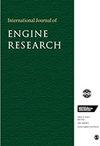研究稳定和瞬态条件下喷油量整形对重型柴油发动机燃烧和排放的影响
IF 2.1
4区 工程技术
Q2 ENGINEERING, MECHANICAL
引用次数: 0
摘要
燃油喷射率(ROI)是影响柴油发动机燃烧和排放的关键因素。本研究的重点是共轨系统中的喷射压力,共轨系统分为高压段和低压段。根据高低喷射压力之间的切换策略,开发了一个面向控制的 ROI 塑造(ROIs)模型。生成了三种 ROI,分别为 ROIB(传统 ROI)、boot-ROI(先低后高注入压力)和 anti-boot-ROI(先高后低注入压力)。通过一维和三维数值模拟,分析了稳定工况和瞬态工况下成型 ROI 对燃烧和排放的影响。从总体结果来看,在三种 ROI 中,引导型 ROI 具有明显优势。在稳定工况下,引导式 ROI 能够提高高负荷工况下的 IMEP(指示平均有效压力)(1.57 巴),而氮氧化物排放量几乎保持不变。在延迟 SOI(喷射开始时间)的低负荷条件下,排气温度接近 ROIB 的排气温度,氮氧化物排放量减少了 0.51 g/kW-h。在瞬态工况下,引导-ROI 也显示出其优势。在减载过程中,它提高了 BSFC(制动比油耗),而氮氧化物排放量几乎保持不变。而在加载过程中,采用 boot-ROI 后,BSFC 和烟尘排放也得到了改善,而氮氧化物排放则因 SOI 的提前而略有增加。在使用 WHTC 循环的实验中,使用 boot-ROI 的一维模型降低了 2 g/kW-h 的燃料消耗,但烟尘排放量略有增加,氮氧化物排放量相近。本文章由计算机程序翻译,如有差异,请以英文原文为准。
Investigation of the effect of injection rate shaping on combustion and emissions in heavy-duty diesel engine under steady and transient conditions
The fuel injection rate (ROI) is a crucial factor that affects the combustion and emissions of diesel engines. This study focuses on the injection pressure in a common rail system, which is divided into a high-pressure section and a low-pressure section. A control-oriented ROI shaping (ROIs) model is developed based on the switching strategy between high and low injection pressure. Three types of ROI were generated, namely ROIB (conventional ROI), boot-ROI (low followed by high injection pressure), and anti-boot-ROI (high followed by low injection pressure) respectively. The 1-D and 3-D numerical simulations are conducted to analyze the impact of the shaped ROI on combustion and emissions for steady condition and transient condition. In terms of overall results, boot-ROI shows significant advantage among the three types of ROI. For the steady condition, the boot-ROI was able to increase the IMEP (indicated mean effective pressure) (1.57 bar) at high load conditions with almost unchanged NOx emission. For low load conditions with delayed SOI (start of injection), the exhaust temperature is close to that of the ROIB with a reduction of 0.51 g/kW·h in NOx emissions. For transient condition, the boot-ROI also shows its advantage. It was found to improve the BSFC (brake specific fuel consumption) with almost unchanged NOx emission during load-down process. And in load-up process, the BSFC and soot emission also could be improved with slightly increase in NOx emission through advance of SOI when boot-ROI was adopted. The one-dimensional model using boot-ROI reduces fuel consumption by 2 g/kW·h in experiment with WHTC cycles, with slightly higher soot emission and similar NOx emission.
求助全文
通过发布文献求助,成功后即可免费获取论文全文。
去求助
来源期刊

International Journal of Engine Research
工程技术-工程:机械
CiteScore
6.50
自引率
16.00%
发文量
130
审稿时长
>12 weeks
期刊介绍:
The International Journal of Engine Research publishes high quality papers on experimental and analytical studies of engine technology.
 求助内容:
求助内容: 应助结果提醒方式:
应助结果提醒方式:


